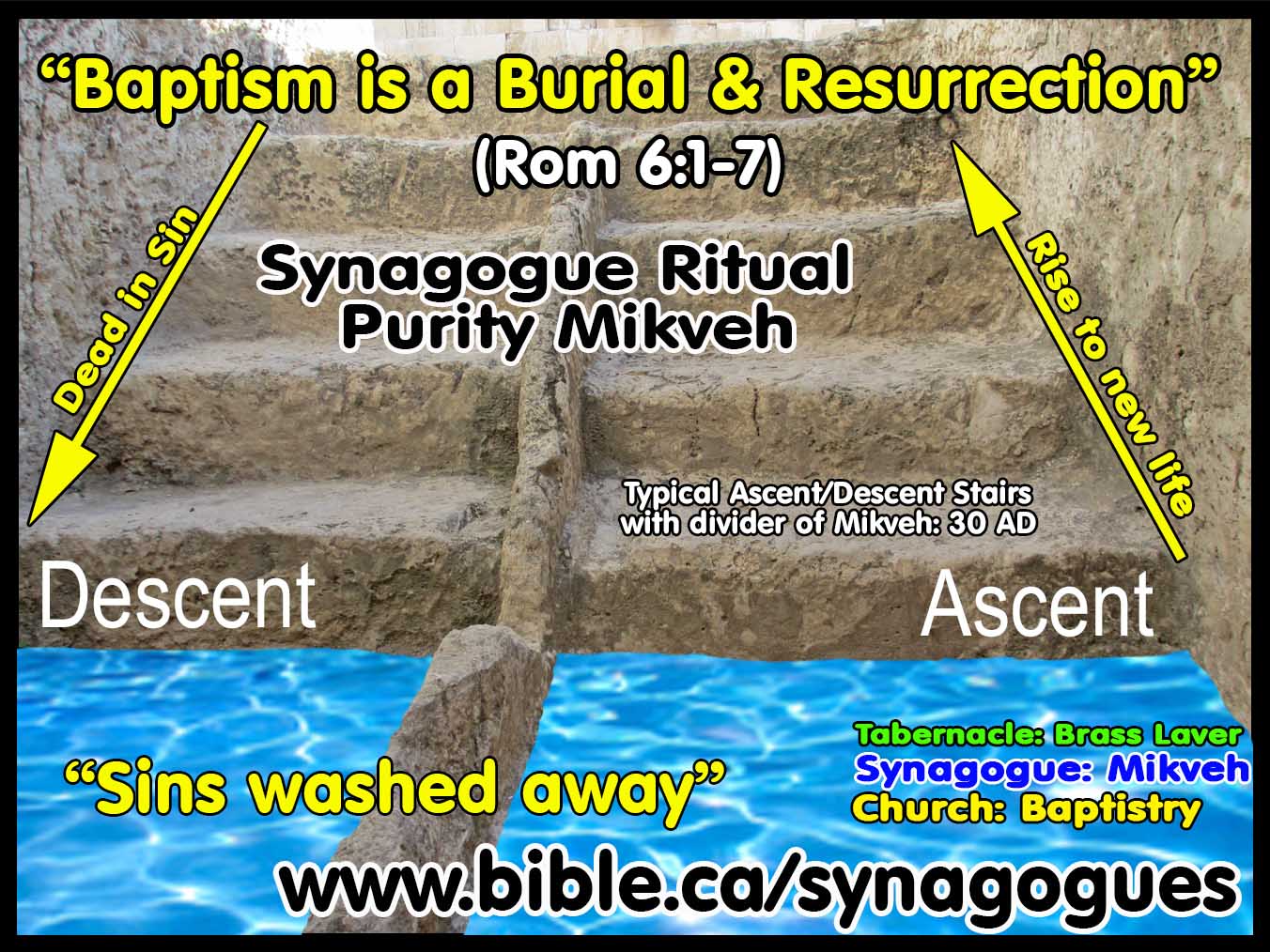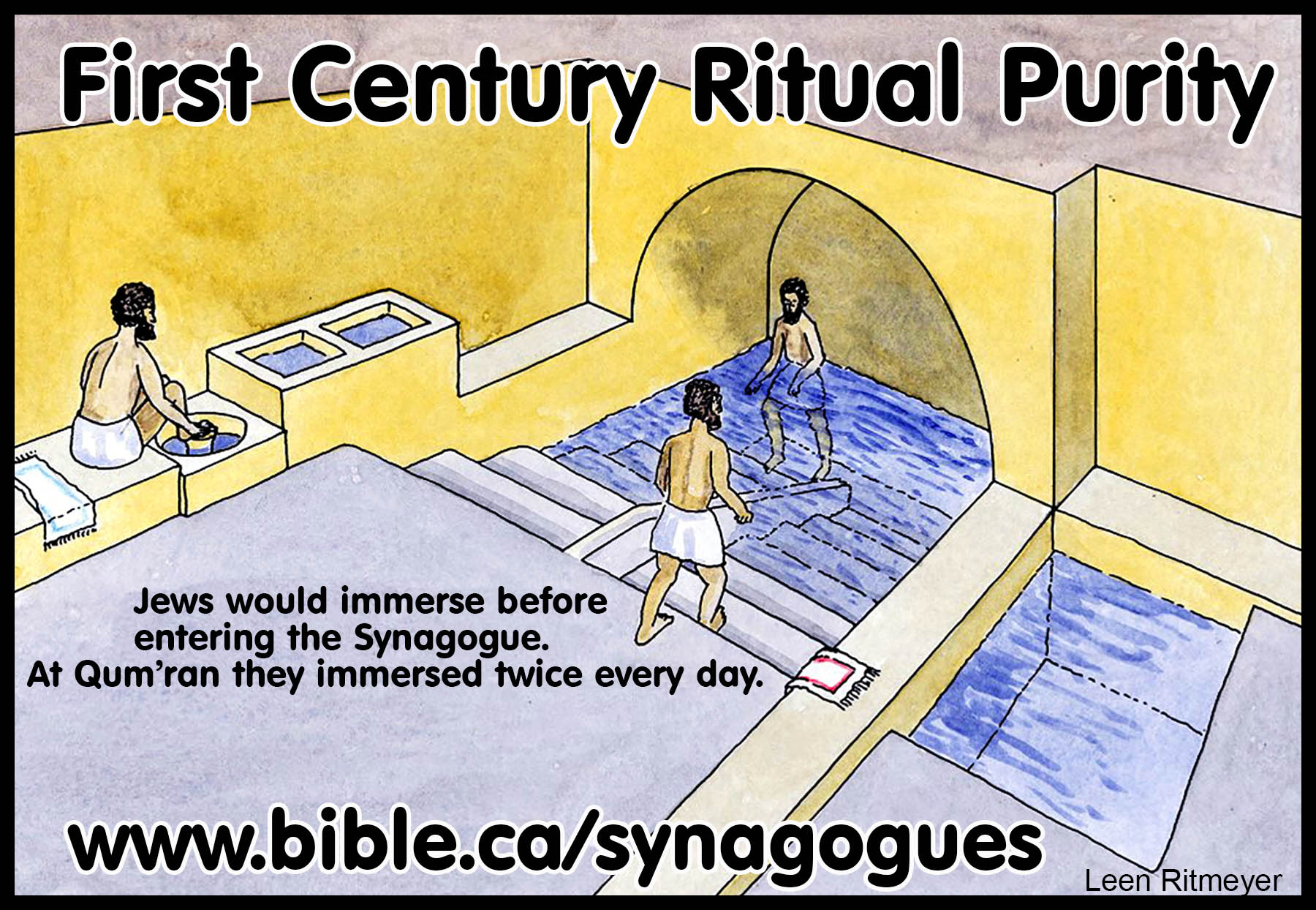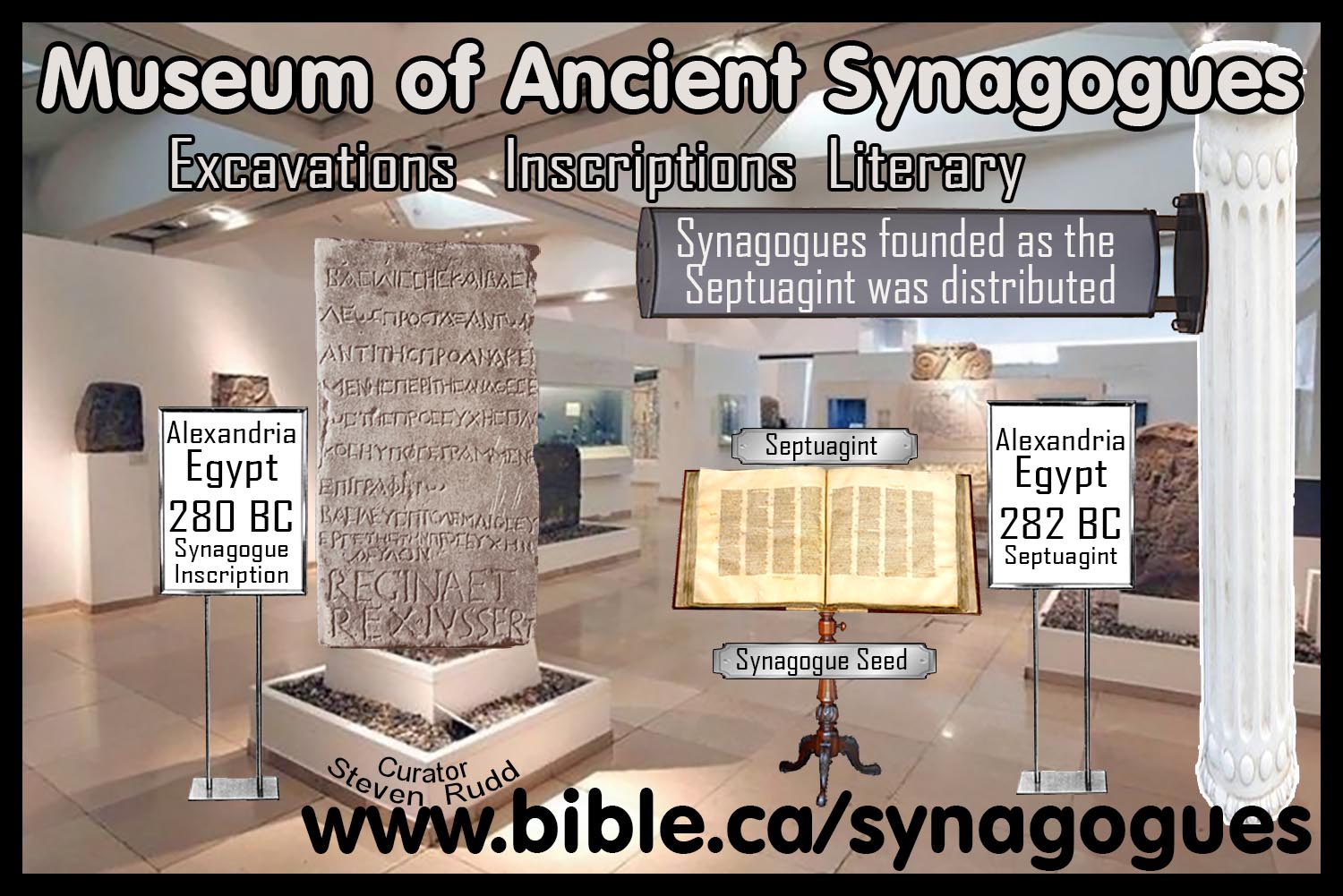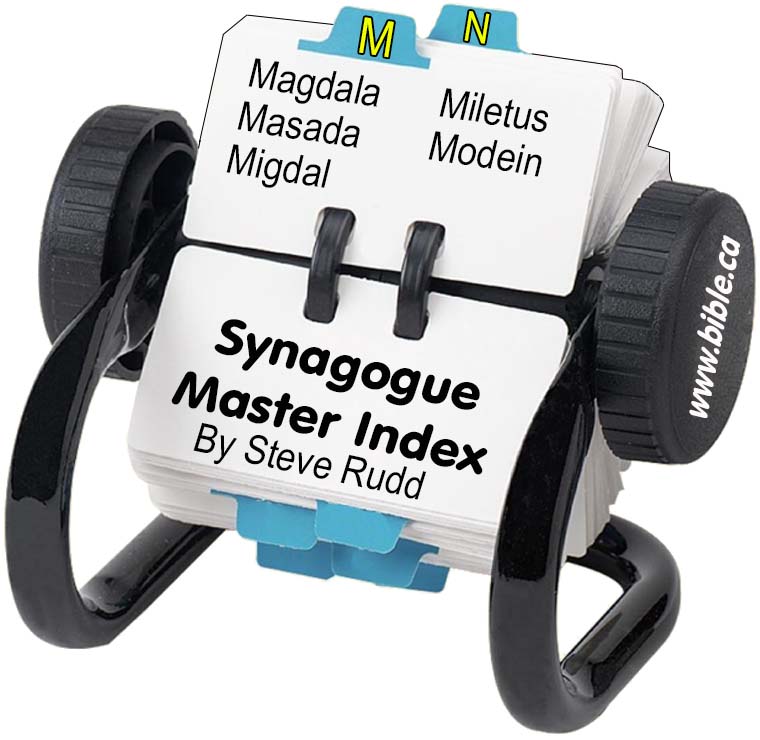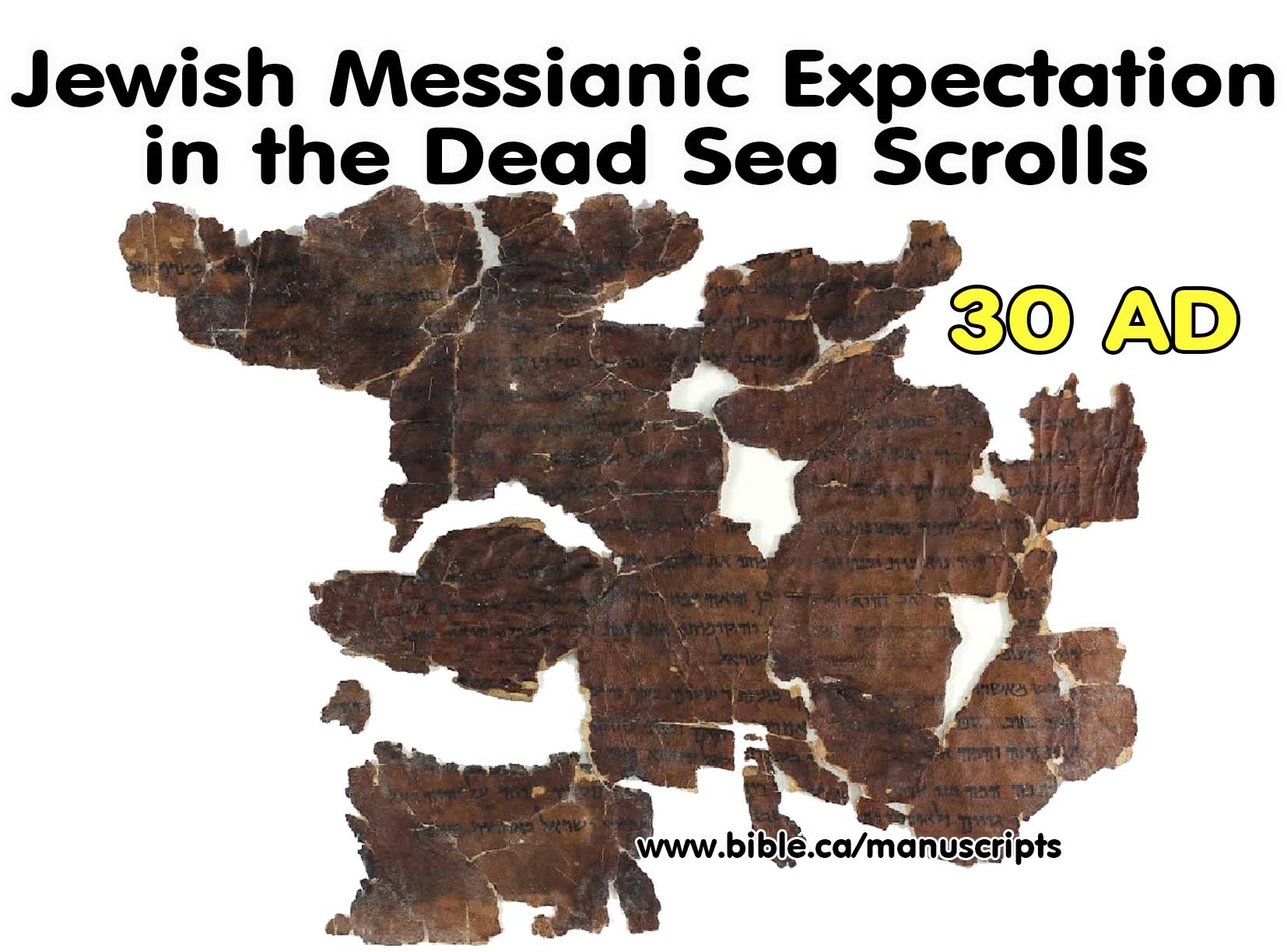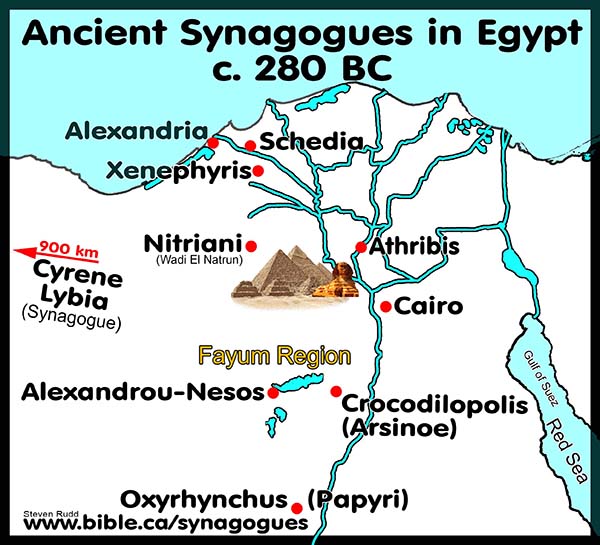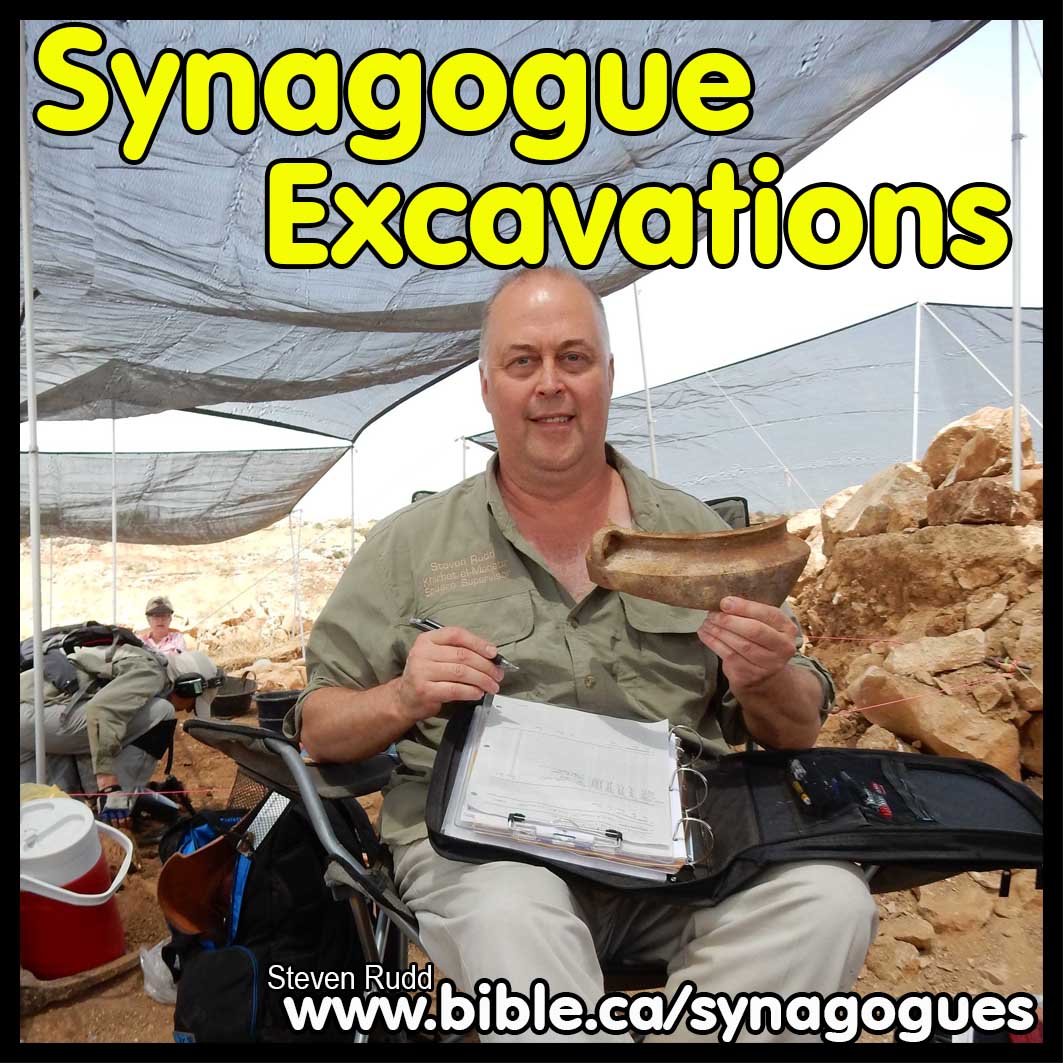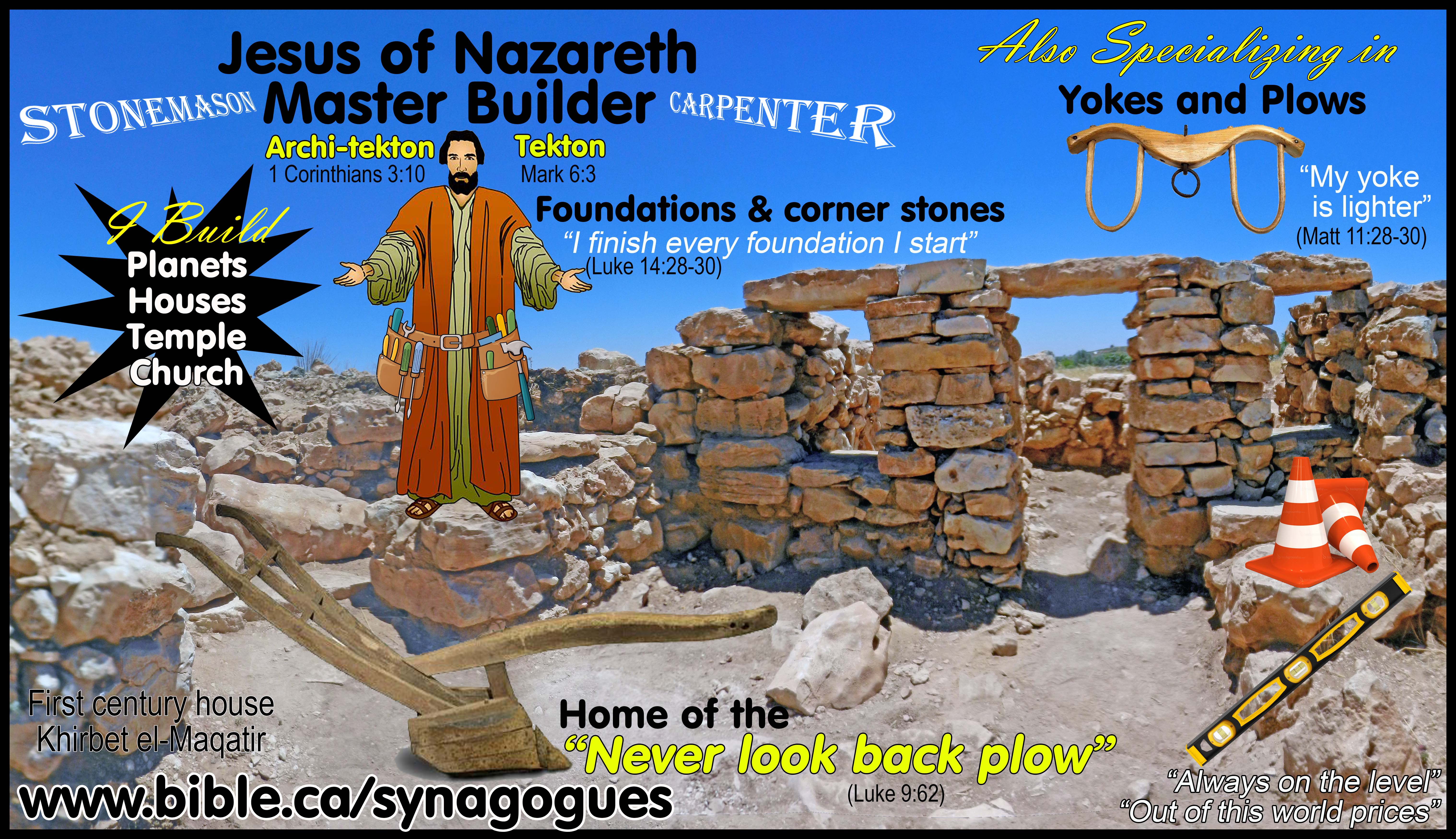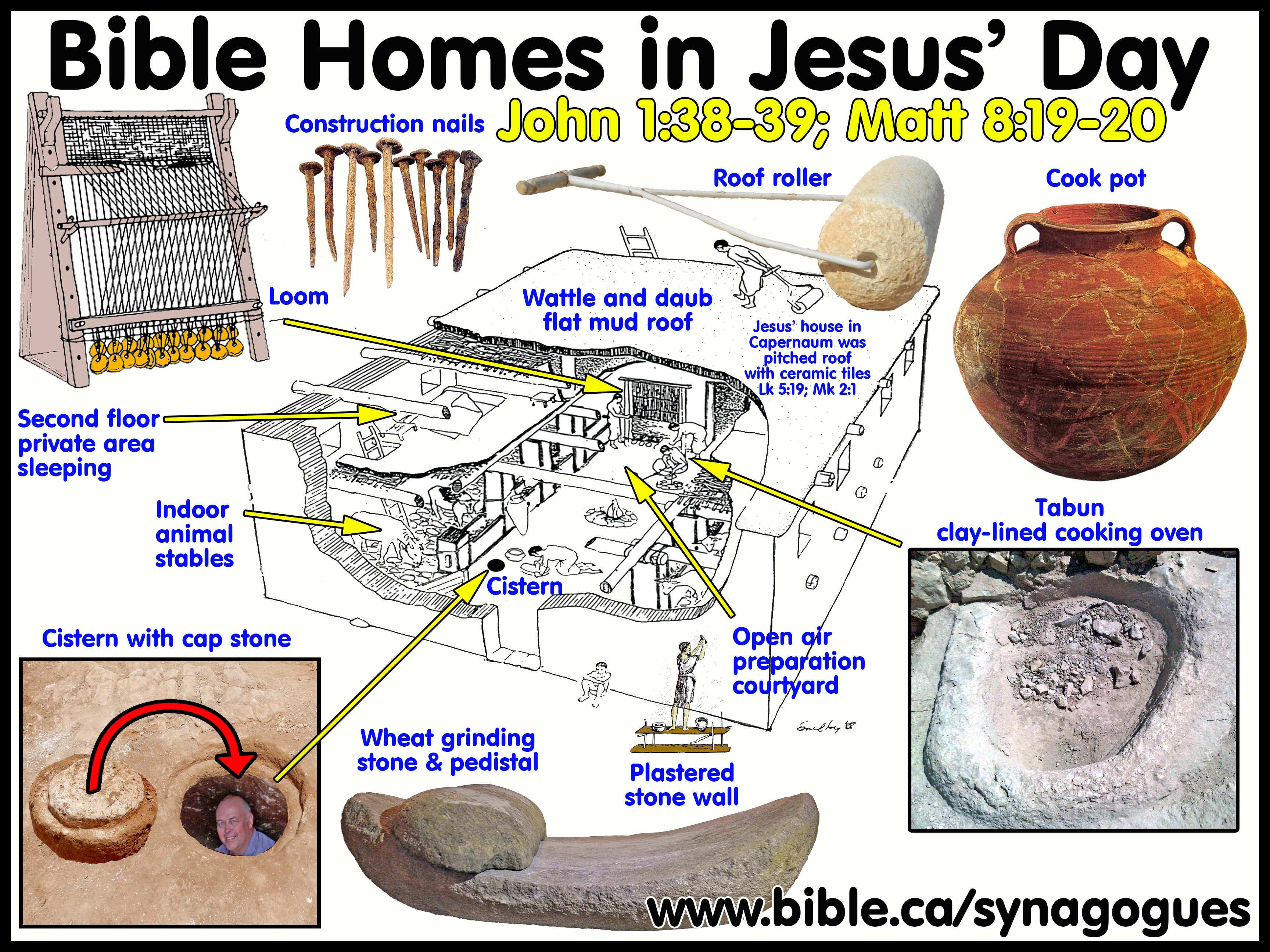Standardized Architectural Synagogue Signature Typology
Synagogue Architecture adopted by the Christian Church
Floorplans and Furnishings of Pre-70 AD Second Temple Period synagogues
|
SYNAGOGUE MIKVEH: THE CHRISTIAN MAKER: Mk 16:16; Acts 2:38; 22:16; 1 Pe 3:21 |
1. The Ritual of using a Mikveh:
a. Every time a Jew would enter the synagogue, he was strip off his clothing, descend into the water “ritually unclean”, immerse himself, then ascend up out of the water on the stairs “ritually clean”
b. In this way the mikveh was a forerunner of Christian water baptism were you have your sins “WASHED AWAY” . (Acts 22:16)
c. When the 20 year Paul was told “"‘Now why do you delay? Get up and be baptized, and wash away your sins, calling on His name.’" (Acts 22:16) this was something he had done over 250 times previously as a Pharisaic Jew, except this time, like all elements of contrast between the old and the new covenants, IT WOULD BE THE LAST, but he attained, once for all, the true forgiveness of sins through the blood of Christ.
d. Paul later immersed in a Mikveh at the temple, probably the pool of Siloam, in order to be admitted into the temple. "Now after several years I came to bring alms to my nation and to present offerings; in which they found me occupied in the temple, having been purified, without any crowd or uproar. But there were some Jews from Asia—" (Acts 24:17–18)
e. Paul likewise circumcised Timothy so he could be admitted into synagogues etc: "Paul came also to Derbe and to Lystra. And a disciple was there, named Timothy, the son of a Jewish woman who was a believer, but his father was a Greek, and he was well spoken of by the brethren who were in Lystra and Iconium. Paul wanted this man to go with him; and he took him and circumcised him because of the Jews who were in those parts, for they all knew that his father was a Greek." (Acts 16:1–3)
|
Jews would immerse every day before entering the synagogue. At Qum’ran they would immerse twice every day.
|
2. It is clear, that in God’s providence and his master eternal plan, that synagogues paved the way for water baptism as the gateway to forgiveness of sins through the first century mikveh.
a. It is actually a mystery why the Jews started practicing full immersion.
b. Jewish full immersion was practiced from 280 BC and a mikveh was a standard architectural feature of every synagogue.
c. FIND THE WATER. FIND THE SYNAGOGUE: Synagogues historically would be placed near a water source for this very reason.
d. However, we know that it must have been God’s providence because immersion was the gateway to forgiveness of sins to contact the blood of Christ.
e. When
f. Paul knew that synagogues were located near rivers and this is how he found Lydia. "And on the Sabbath day we went outside the gate to a riverside, where we were supposing that there would be a place of prayer [Synagogue]; and we sat down and began speaking to the women who had assembled." (Acts 16:13)
g.
Here is a papyrus record of the water bill for two synagogues in
Crocodilopolis, Egypt in 113 AD. Just like a property owner with a hot tub, you
need a lot of water to run a synagogue due to evaporation.
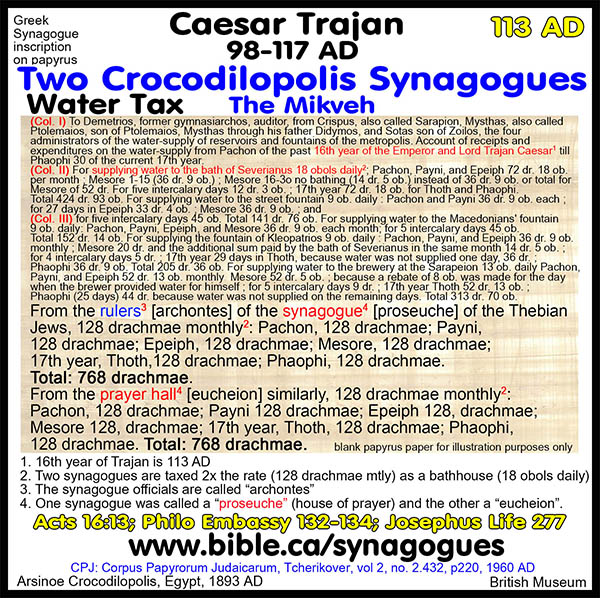
3. There is direct line that connects Christian baptism to the Synagogue mikveh which in turn derives its origin from the Tabernacle brass wash basin.
a. "The LORD spoke to Moses, saying, “You shall also make a laver of bronze, with its base of bronze, for washing; and you shall put it between the tent of meeting and the altar, and you shall put water in it. “Aaron and his sons shall wash their hands and their feet from it; when they enter the tent of meeting, they shall wash with water, so that they will not die; or when they approach the altar to minister, by offering up in smoke a fire sacrifice to the LORD. “So they shall wash their hands and their feet, so that they will not die; and it shall be a perpetual statute for them, for Aaron and his descendants throughout their generations.”" (Exodus 30:17-21)
b. What is interesting is that the figure of ceremonial cleansing was at first sprinkling in the tabernacle and temple but this changed in 280 BC with the Mikveh which featured full immersion.
c.
In this way the figure of water “washing away sins” was transferred from
Mosaic Judaism to synagogue worship to the church.

4.
Gamla, Jericho, Modein and Ostia Synagogue top plan show the location of
the mikvaot:
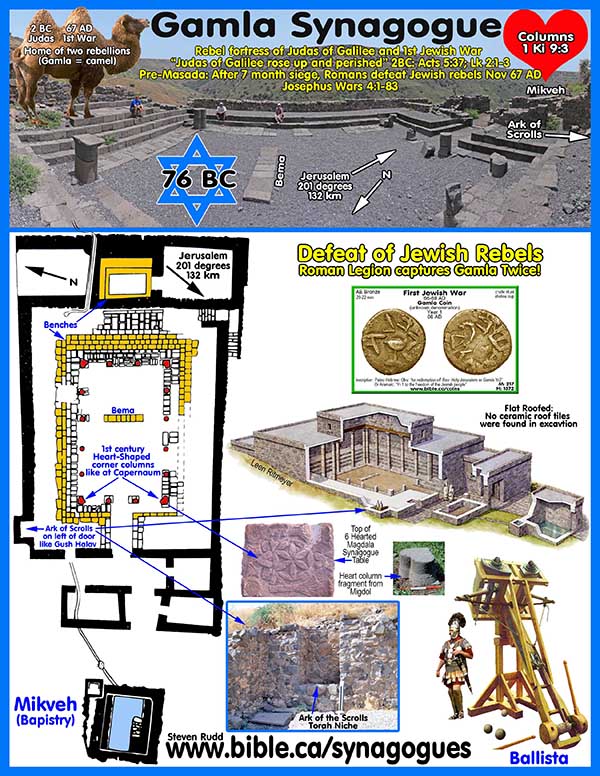
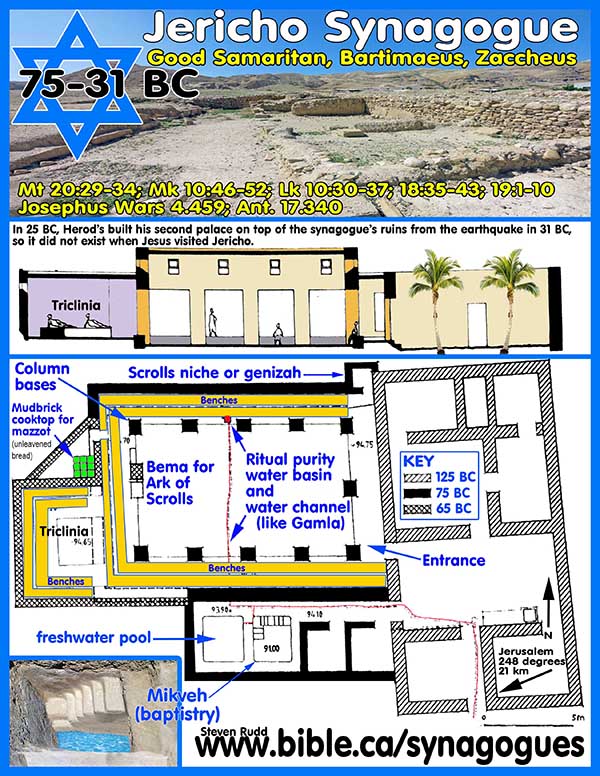
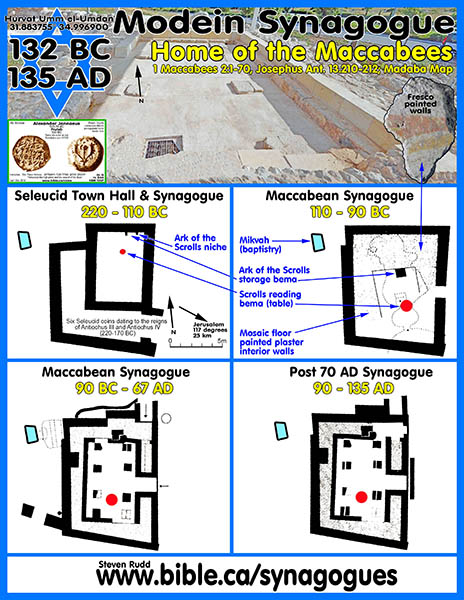
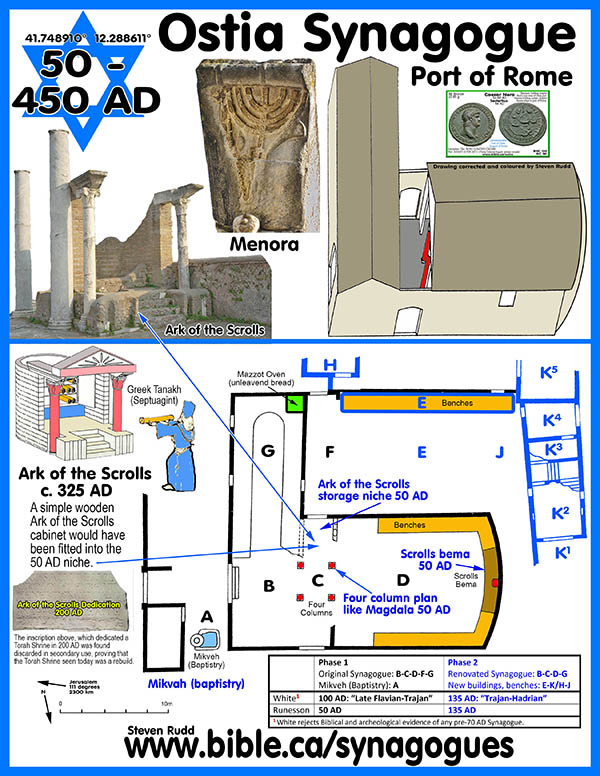
a. All the earliest synagogues featured a mikveh located directly beside or very nearby. As part of a spiritual cleansing ritual, Jews would fully immerse in a mikveh before entering the synagogue.
b. Just as the priests had to wash their hands and feet with water before entering the Holy Place, so too the Jews felt it important to go one step further and fully immerse their entire bodies before entering the Synagogue.
5.
Every ancient synagogue had a Mikveh. Jericho had two Mikvaot:
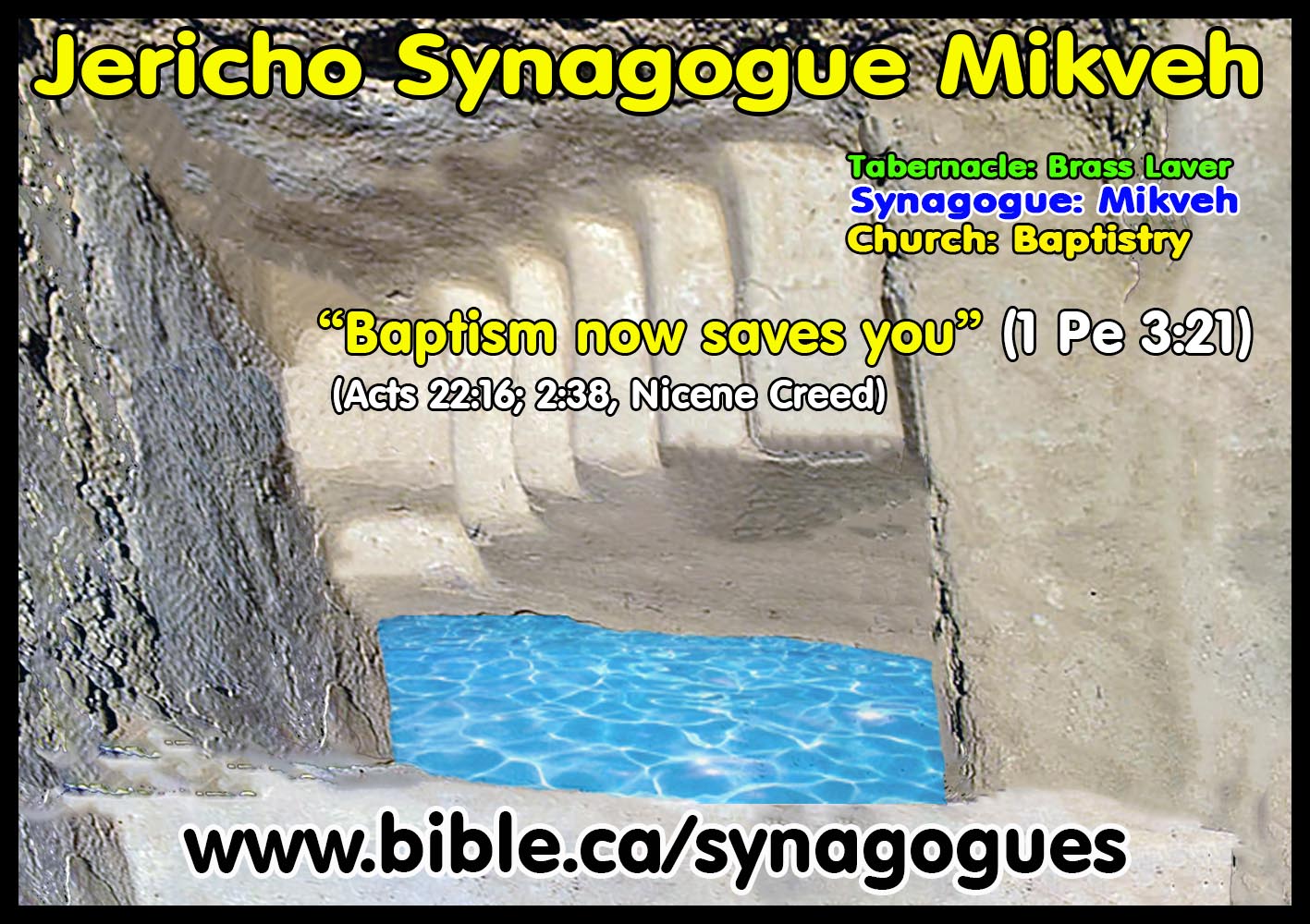

6.
Herodium also had two Mikvaot:
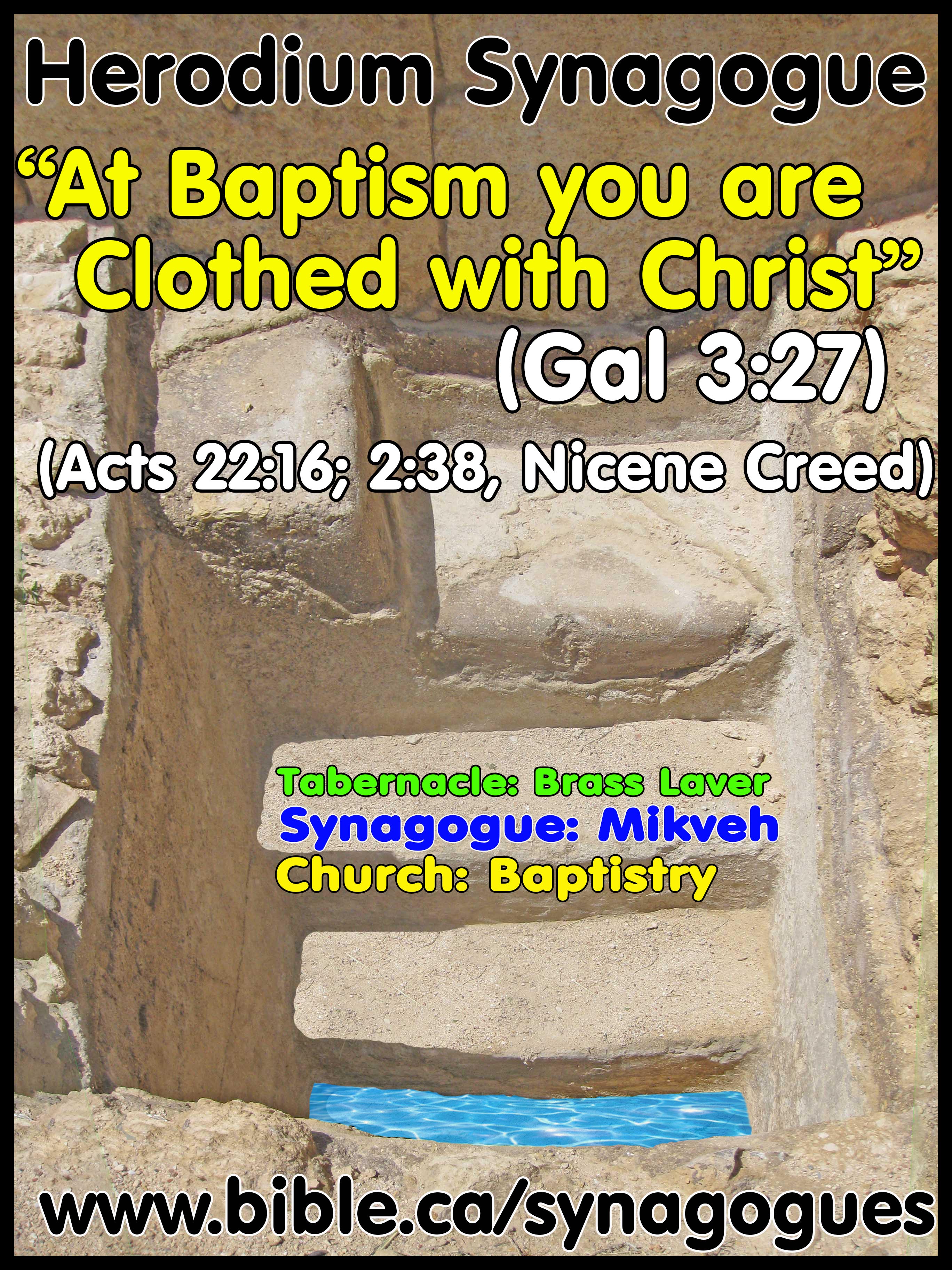
7.
This feature is carried over into the church as can be seen that all
early churches had full immersion baptistries, like at Shiloh. Col 2:11-13
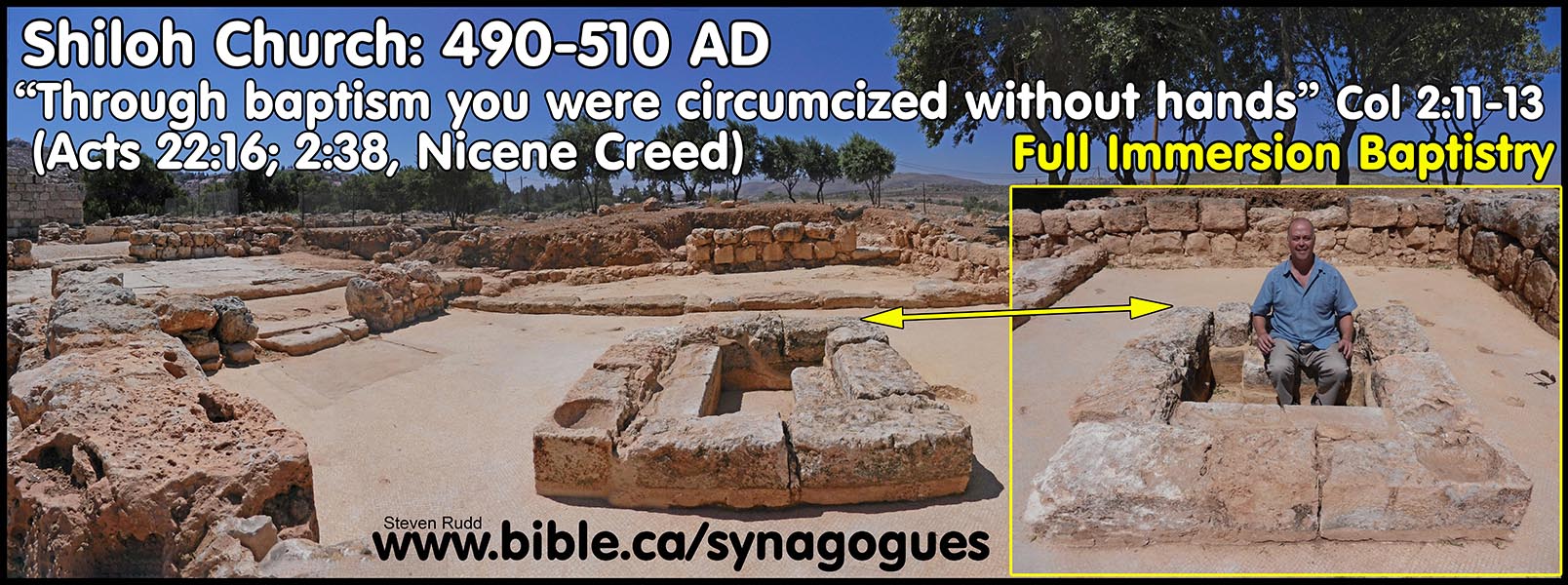
8.
In December 2012, a perfect full immersion baptistry was excavated at
the church at Khirbet el-Maqatir by Director of Excavations, Dr. Scott
Stripling and square supervisor Abigail Leavitt:
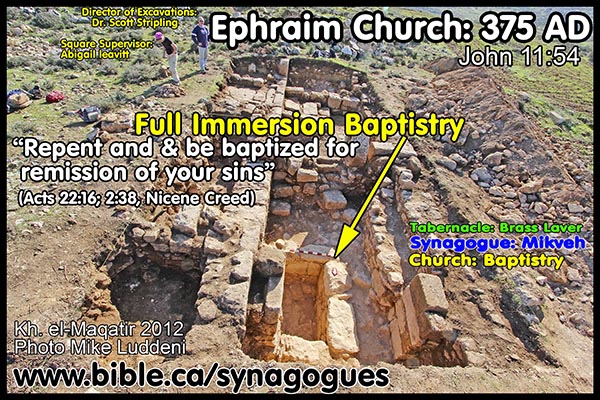
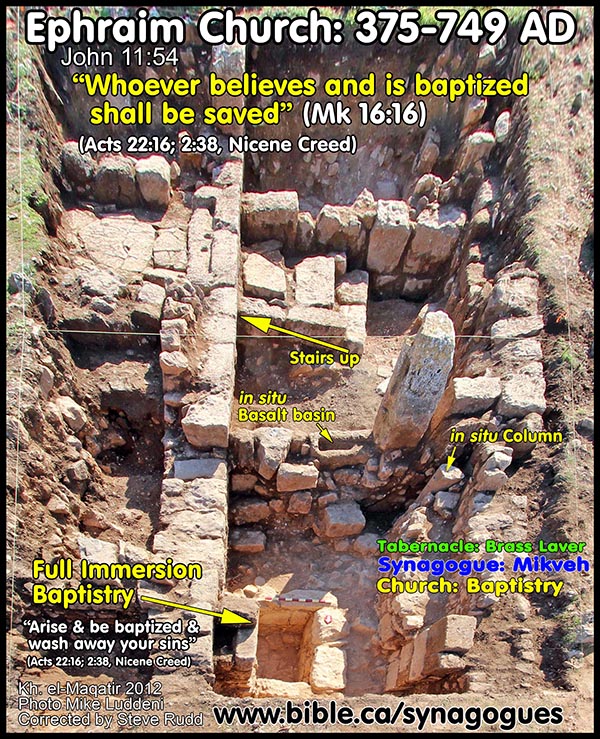
9.
An in situ Byzantine baptistry was discovered at this famous
location that dates back to the late bronze age when it was known as the Ai of
Joshua, second conquest city. In the first century it was the town of Ephraim
of John 11. In May 2016 AD, Steve Rudd supervised the excavation of five
sections of in situ flooring and was able to determine that the
Byzantines built a memorial church here in 375 AD which was destroyed by an
earthquake in 383 AD. Under one section of floor a hoard of 22 coins was
discovered along with a fragment of chancel screen. The church was rebuilt
around 400 AD, eventually being occupied by the Muslims only to be destroyed
finally in 749 AD.
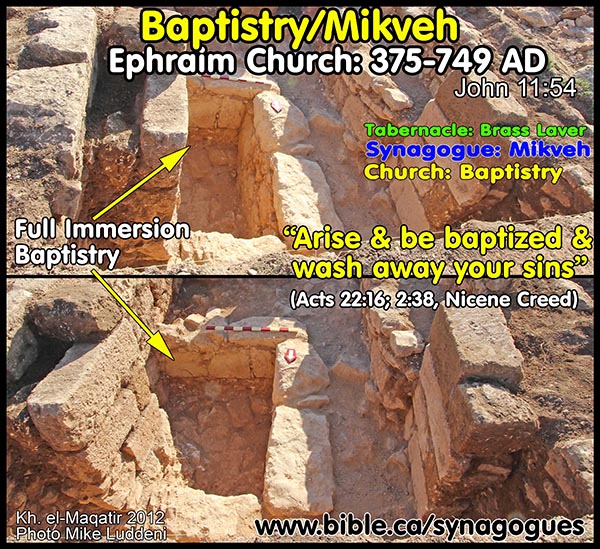
10. In Christian theology, salvation and forgiveness of sins is attained at the point of water baptism. There are five metaphors for water baptism:
a. Cleansing and washing away of sins: Acts 2:38; 22:16
b. Putting on clothing of Salvation: Gal 3:26-27
c. New birth: Jn 3:3-5
d. Circumcision: Col 2:12
e. Re-enactment ceremony of the death, burial and resurrection of Christ: Rom 6:3-7; Col 2:12
f. The Nicene Creed of 325 AD, verifies that this is the first century tradition and explains why full immersion baptistries were built directly into all Byzantine churches.
11. The
recently excavated pool of Shalom in Jerusalem features an Olympic size mikveh
with two different sets of stairs (500 meters long) that connect the temple to
the pool.
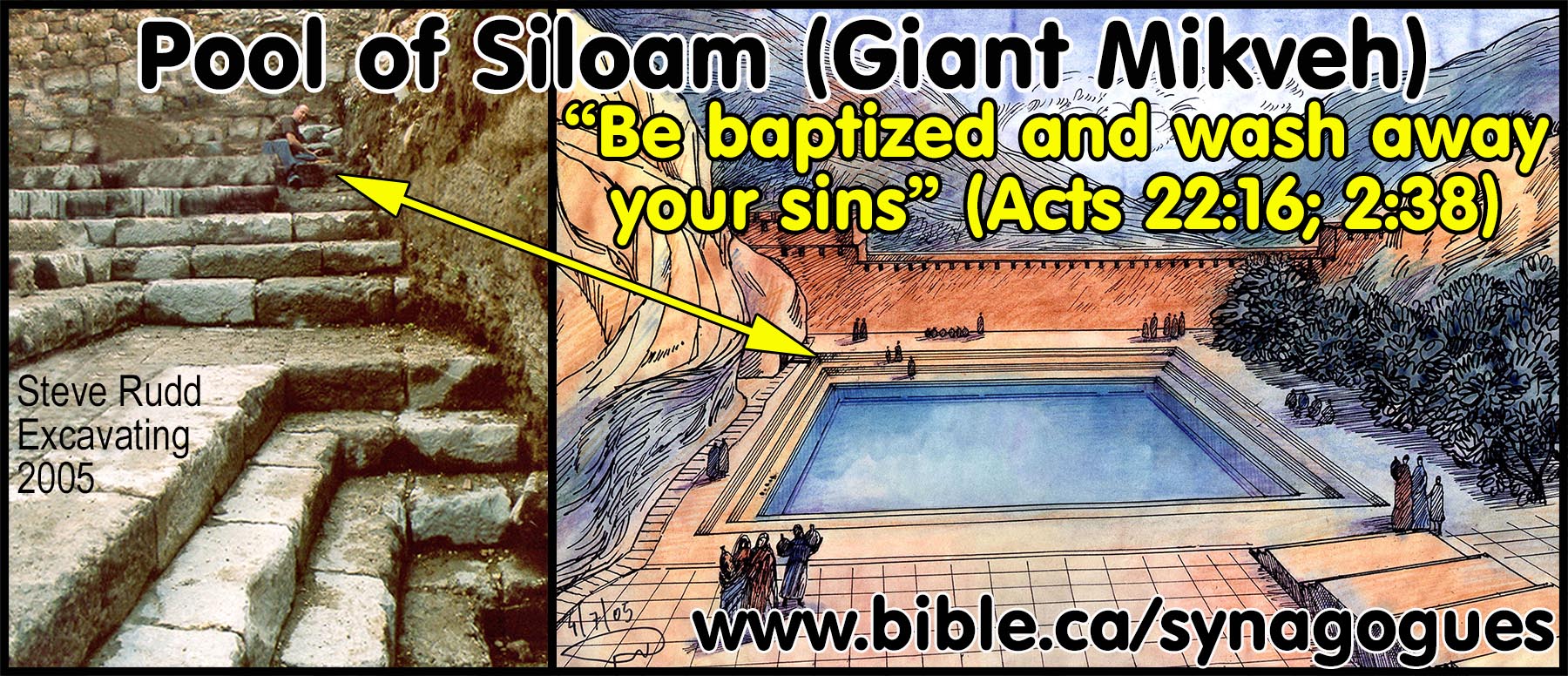
a. Paul probably “purified himself” in the pool of Siloam: "Now after several years I came to bring alms to my nation and to present offerings; in which they found me occupied in the temple, having been purified, without any crowd or uproar. But there were some Jews from Asia—" (Acts 24:17–18)
b. The Jew would arrive at the temple, then walk down the descent stairs to the pool of Shalom, then immerse in the pool, then put on a white robe, then return to the Temple of Herod using a separate set of stairs (500 meters long, that ran parallel to the descent stairs), back to the temple above.
c. The "pool of Siloam is found 3 times in the Bible at early as 730 BC: Is 8:6, "waters of Shiloah"; Neh 3:15 "Pool of Shelah; Jn 9:7, "pool of Siloam".
d. Josephus said the pool of Siloam was located at the end "Valley of the Cheesemongers" or the Tyropoeon Valley (Josephus, Wars 5.4.1). He also said it was outside the city wall (Josephus, Wars 5.9.4) at a place where the old wall bent to the east (towards the rising sun) (Wars 5.6.1), but also facing the hill upon which was a rock called "Peristereon", which was further East (Josephus, Wars 5.12.2). Josephus was likely making reference to the present Birket Silwan, on the other side of the Kidron valley.
e. While its original use was not likely connected with spiritual cleansing and the temple of Solomon, it is clear that when Herod the Great remodelled the ancient pool of Siloam in 18 BC, that he was adopting its use to current practice as a Mikveh.
f. Pictured above is the author excavating the stairs that encircled the pool of Siloam.
12. Josephus tells us one amazing bit of history connected with the Pool of Siloam is how the Romans found 2000 Jews hiding in the drainage ditch below the ascent stairs when Titus destroyed Jerusalem, fulfilling Jesus prophecy of Matthew 24 in 70 AD.
a. “Now this vast multitude is indeed collected out of remote places, but the entire nation was now shut up by fate as in a prison, and the Roman army encompassed the city when it was crowded with inhabitants. Accordingly the multitude of those that therein perished exceeded all the destructions that either men or God ever brought upon the world; for, to speak only of what was publicly known, the Romans slew some of them, some they carried captives, and others they made search for underground, and when they found where they were, they broke up the ground and slew all they met with. There were also found slain there above two thousand persons, partly by their own hands, and partly by one another, but chiefly destroyed by the famine” (Josephus, Wars 6.428-430, 70 AD)
b. In a stunning confirmation of Josephus, when the stairs were excavated in 2006, the very place where the Romans broke through the stairs to kill the hiding Jews below was discovered. Although the valuables had been looted by the Roman soldiers, the many whole Roman cookpots they left have been excavated and are in museums for all to see.
13. Pool of Siloam Ascent and Descent Stairs
a. There were two parallel sets of stairs between the pool of Siloam and the Temple of Herod about 500 meters long.
b.
The worshipper would arrived at the temple, take the descent stairs down
to the pool, be immersed, then put on a white robe and take the ascent stairs
(pictured below) back up to the Temple “cleansed of sins”
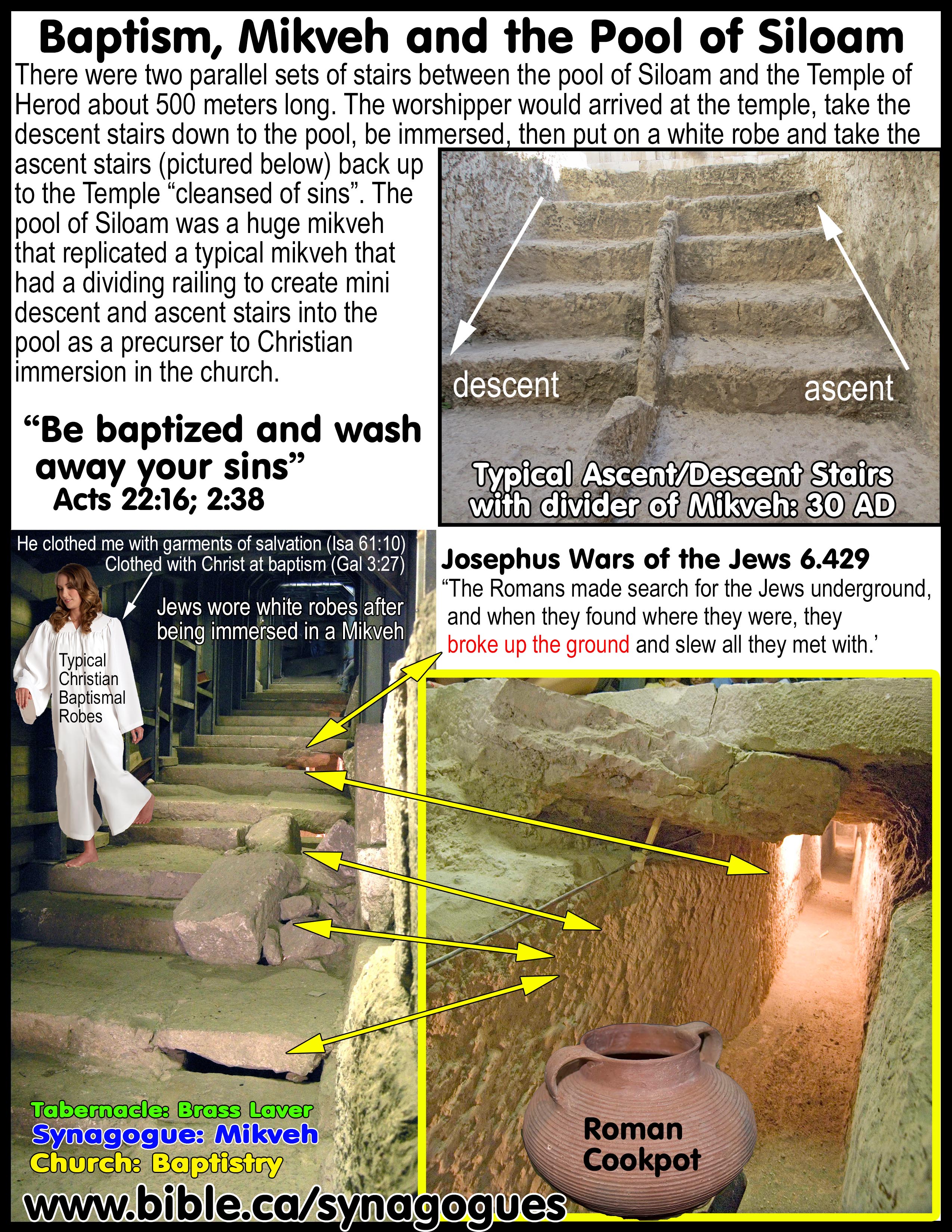
14. Garments of salvation = putting on Christ: What is even more amazing is the connection between the wearing of physical white robes after being immersed in a Synagogue mikveh and the symbolic wearing of Christ after Christian baptism (immersion)
a. A Jew would strip naked and descend down the “descent stairs” to the Mikveh and immerse himself, then climb the “ascent stairs” where he would be given a white robe symbolizing his ceremonial washing away of his sins.
b. It is likely that the Jews adopted this practice of wearing white robes after being baptized in the Mikveh from: "I will rejoice greatly in the Lord, My soul will exult in my God; For He has clothed me with garments of salvation, He has wrapped me with a robe of righteousness, As a bridegroom decks himself with a garland, And as a bride adorns herself with her jewels." (Isaiah 61:10)
c. This is the precise symbolic imagery used by Paul, a Pharisee, of Christian baptism in Gal 3:27 where the newly minted Christian arises born again to “Put on” Christ: "For all of you who were baptized into Christ have clothed yourselves with Christ." (Galatians 3:27)
d. "‘But you have a few people in Sardis who have not soiled their garments; and they will walk with Me in white, for they are worthy. "Or do you not know that the unrighteous will not inherit the kingdom of God? Do not be deceived; neither fornicators, nor idolaters, nor adulterers, nor effeminate, nor deviant sex practitioners, nor thieves, nor the covetous, nor drunkards, nor revilers, nor swindlers, will inherit the kingdom of God. Such were some of you; but you were washed, but you were sanctified, but you were justified in the name of the Lord Jesus Christ and in the Spirit of our God." (1 Corinthians 6:9–11)
e. ‘He who overcomes will thus be clothed in white garments; and I will not erase his name from the book of life, and I will confess his name before My Father and before His angels." (Revelation 3:4–5)
f. Today, Christians wear the same white robes at baptism that Jews wore 2000 years ago when they immersed in a Mikveh.
15. Old Testament allusions to ritual purity before Mikvehs came into use in 280 BC.
a. "“Wash yourselves, make yourselves clean; Remove the evil of your deeds from My sight. Cease to do evil," (Isaiah 1:16)
b. "When the Lord has washed away the filth of the daughters of Zion and purged the bloodshed of Jerusalem from her midst, by the spirit of judgment and the spirit of burning," (Isaiah 4:4)
c. "“Although you wash yourself with lye And use much soap, The stain of your iniquity is before Me,” declares the Lord God." (Jeremiah 2:22)
d. "Wash your heart from evil, O Jerusalem, That you may be saved. How long will your wicked thoughts Lodge within you?" (Jeremiah 4:14)
16. New Testament allusions to ritual purity and Mikvehs in the New Testament:
a. "so that He might sanctify her, having cleansed her by the washing of water with the word," (Ephesians 5:26)
b. "He saved us, not on the basis of deeds which we have done in righteousness, but according to His mercy, by the washing of regeneration and renewing by the Holy Spirit," (Titus 3:5)
c. "let us draw near with a sincere heart in full assurance of faith, having our hearts sprinkled clean from an evil conscience and our bodies washed with pure water." (Hebrews 10:22)
d. "When Pilate saw that he was accomplishing nothing, but rather that a riot was starting, he took water and washed his hands in front of the crowd, saying, “I am innocent of this Man’s blood; see to that yourselves.”" (Matthew 27:24)
e. "He answered, “The man who is called Jesus made clay, and anointed my eyes, and said to me, ‘Go to Siloam and wash’; so I went away and washed, and I received sight.”" (John 9:11)
f. "‘Now why do you delay? Get up and be baptized, and wash away your sins, calling on His name.’" (Acts 22:16)
g. "Therefore leaving the elementary teaching about the Christ, let us press on to maturity, not laying again a foundation of repentance from dead works and of faith toward God, of instruction about BAPTISMS [Greek: immersions in a Jewish Mikveh] and laying on of hands, and the resurrection of the dead and eternal judgment." (Hebrews 6:1–2)
17. Foot washing of Jn 13 uses same word in other passages: [Greek: Louō]
a. "“You are already clean because of the word [not through a mikveh] which I have spoken to you." (John 15:3)
b. "Then He poured water into the basin, and began to wash [Greek: Louō] the disciples’ feet and to wipe them with the towel with which He was girded. So He came to Simon Peter. He said to Him, “Lord, do You wash my feet?” Jesus answered and said to him, “What I do you do not realize now, but you will understand hereafter.” Peter said to Him, “Never shall You wash my feet!” Jesus answered him, “If I do not wash you, you have no part with Me.” Simon Peter said to Him, “Lord, then wash not only my feet, but also my hands and my head [ie. full immersion in a mikveh].” Jesus said to him, “He who has bathed [Greek: Louō] needs only to wash his feet, but is completely clean; and you are clean, but not all of you.”" (John 13:5–10)
c. "let us draw near with a sincere heart in full assurance of faith, having our hearts sprinkled clean from an evil conscience and our bodies washed [Greek: Louō] with pure water." (Hebrews 10:22)
d. "It has happened to them according to the true proverb, “A dog returns to its own vomit,” and, “A sow, after washing [Greek: Louō], returns to wallowing in the mire.”" (2 Peter 2:22)
18. WHERE DID ALL THE MIKVAOT GO IN MODERN SYNAGOGUES?
a. The usual reason given for the removal of Mikveh is that after the destruction of the Temple in 70 AD, Jews lost interest or felt there was no need for ritual purity.
b. Author’s Theory why Mikveh were removed: Synagogue Mikveh’s were CHRISTIAN MAKERS, so the Jews removed them from their later synagogues.
c. The earlier synagogues (280 – 100 AD) all had Mikveh but the later ones did not!
d. Mikveh’s convert Jews into Christians so they were removed from later synagogues because of the loss of weekly synagogue sabbath attending Jews who started worshipping the Messiah on Sunday, the day Jesus rose from the dead, the first day of the week.
e. Every time a Jew looked at the Mikveh in the post 70 AD world, it reminded him of countless friends who had their sins forgiven by the blood of Christ through Christian baptism IN THE SYNAGOGUE MIKVEH. So the Jews broke with 400 years of synagogue tradition and removed the Mikveh’s from the synagogues or stopped building them architecturally into new synagogues.
f. As part of ritual purity of the first century, all synagogues had one or more Mikvehs, but today they are universally absent from modern synagogues.
g. The damage done by Mikvehs installed in Synagogues to the Torah observant Jewish community through loss members who were baptized into Christ, far outweighed any concern for ritual purity.
h. Besides, immersing in a Mikveh before you enter a modern synagogue is messy and time consuming.
i. “Reich (1995:296-7) notes an interesting detail. Some of the Second Temple synagogues had a miqveh connected to them (Gamla, Masada, Herodium, the Theodotos inscription in Jerusalem, which was found in a cistern), while the later period synagogues usually do not, except for Sasa and Korazim. Other synagogues have only water installations (see Beth She'arim, Khirbet Shem`a, Ma`on). It seems that in the Mishnah and Talmud periods there is no linkage between the two institutions of the synagogue and the miqveh. The linkage in the Second Temple period might be due to the practice of holding sacred meals, which would have required some purification ritual by the participants, or that the reading, study, or worship of the Torah (by the Zealots) required some purity. Adler (2008:72) maintains that the miqveh built adjacent to these synagogues was intended "for ablutions prior to engagement in Torah study and prayer for individuals who had experienced seminal emission" following a rabbinical enactment. Yet it should be noted that not only synagogues had an adjacent miqveh; the Goliath Tomb at Jericho also had one which had a different function.” (Ancient Synagogues - Archaeology and Art: New Discoveries and Current Research, Rachel Hachlili, p45, footnotes, 2013 AD)
j. Modified Peter Paul and Mary song: “Where have all the Mikvaot gone, long time passing? Where have all the Mikvaot gone, long time ago? Where have all the Mikvaot gone? Torah observant Jews removed them, every one. Oh when will they ever learn, oh when will they ever learn? (See Acts 22:16)”
k. It is clear, that in God’s providence and his master eternal plan, that synagogues paved the way for water baptism as the gateway to forgiveness of sins through the first century mikveh.
By Steve Rudd 2017: Contact the author for comments, input or corrections
|
Jesus your messiah is waiting for you to come home! |
|
|
Why not worship with a first century New Testament church near you, that has the same look and feel as the Jewish Synagogue in your own home town. As a Jew, you will find the transition as easy today as it was for the tens of thousands of your forefathers living in Jerusalem 2000 years ago when they believed in Jesus the Nazarene (the branch) as their messiah. It’s time to come home! |
|
By Steve Rudd: Contact the author for comments, input or corrections.
Go to: Main Ancient Synagogue Start Page
